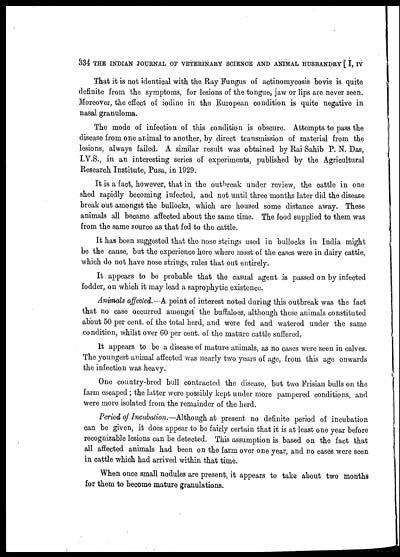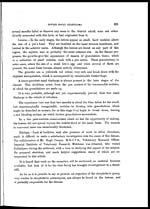Medicine - Veterinary > Veterinary colleges and laboratories > Indian journal of veterinary science and animal husbandry > Volume 1, 1931 > Part IV (December 1931) > Bovine nasal granuloma
(381) Page 334
Download files
Individual page:
Thumbnail gallery: Grid view | List view

334 THE INDIAN JOURNAL OF VETERINARY SCIENCE AND ANIMAL HUSBANDRY [ I, IV
That it is not identical with the Ray Fungus of actinomycosis bovis is quite
definite from the symptoms, for lesions of the tongue, jaw or lips are never seen.
Moreover, the effect of iodine in the European condition is quite negative in
nasal granuloma.
The mode of infection of this condition is obscure. Attempts to pass the
disease from one animal to another, by direct transmission of material from the
lesions, always failed. A similar result was obtained by Rai Sahib P. N. Das,
I.V.S., in an interesting series of experiments, published by the Agricultural
Research Institute, Pusa, in 1929.
It is a fact, however, that in the outbreak under review, the cattle in one
shed rapidly becoming infected, and not until three months later did the disease
break out amongst the bullocks, which are housed some distance away. These
animals all became affected about the same time. The food supplied to them was
from the same source as that fed to the cattle.
It has been suggested that the nose strings used in bullocks in India might
be the cause, but the experience here where most of the cases were in dairy cattle,
which do not have nose strings, rules that out entirely.
It appears to be probable that the casual agent is passed on by infected
fodder, on which it may lead a saprophytic existence.
Animals affected.-A point of interest noted during this outbreak was the fact
that no case occurred amongst the buffaloes, although these animals constituted
about 50 per cent, of the total herd, and were fed and watered under the same
condition, whilst over 60 per cent, of the mature cattle suffered.
It appears to be a disease of mature animals, as no cases were seen in calves.
The youngest animal affected was nearly two years of age, from this age onwards
the infection was heavy.
One country-bred bull contracted the disease, but two Frisian bulls on the
farm escaped ; the latter were possibly kept under more pampered conditions, and
were more isolated from the remainder of the herd.
Period of Incubation.—Although at present no definite period of incubation
can be given, it does appear to be fairly certain that it is at least one year before
recognizable lesions can be detected. This assumption is based on the fact that
all affected animals had been on the farm over one year, and no cases were seen
in cattle which had arrived within that time.
When once small nodules are present, it appears to take about two months
for them to become mature granulations.
Set display mode to: Large image | Zoom image | Transcription
Images and transcriptions on this page, including medium image downloads, may be used under the Creative Commons Attribution 4.0 International Licence unless otherwise stated. ![]()
| Permanent URL | https://digital.nls.uk/75226938 |
|---|
| Description | Covers articles from 1931. |
|---|




